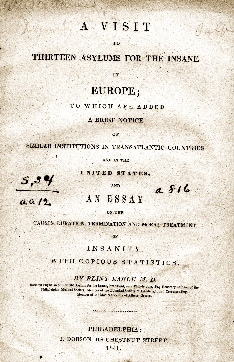|
|

One of the most thorough accounts of the punitive use of hydrotherapy comes from an American. Pliny Earle, resident physician at the Friends' Asylum in Frankford, Pennsylvania, toured the Bic�tre in 1840, when Fran�ois Leuret was its director, and left behind a description of the punitive use of the douche as a moral agent, designed to persuade patients to renounce their fantastical ideas. Earle described two cases, the first a delusional patient who thought himself a nobleman, and the second a patient who refused to work. |
Pliny Earle (1809-1892) F. B. Sanford, Memoirs of Pliny Earle, M.D. Boston: Damrell & Upham, 1898. |
Pliny Earle, A visit to thirteen asylums for the insane in Europe. Philadelphia: J. Dobson, 1841. |
(To read Earle's account of the douche, click on the title page image) |
To such a course of treatment, Earle, a Quaker, was resolutely opposed. Indeed, he described it as 'destitute of utility,' and declared it was evident that 'the douche compelled the man to sacrifice truth on the altar of fear.' Yet Earle did not reject hydrotherapy entirely. Instead, he argued that though water should not be used coercively, it could be useful and effective in some cases. When Earle became superintendent of Bloomingdale Asylum in 1844, he forbade the use of the douche as punishment, permitting it only when the patient consented to or requested the procedure. |
